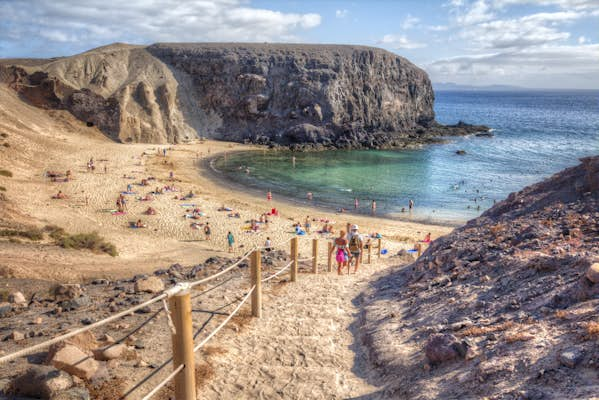Isabella is one of the writers on the new Canary Islands guidebookspending weeks researching Tenerife and Lanzarote. Here she shares her top tips on stretching your budget on your next sun trip.
Unlike Spain's famously glamorous Balearic Islands, the Canaries are widely considered a good-value destination, with a raft of sensibly priced accommodation, dining options, monuments and activities to tempt budget-conscious travelers. That doesn't make them a shoestring destination though, and major local events – like Carnaval – paired with a double beach-holiday season can send costs skyrocketing.
Planning your trip to the Canary Islands to sidestep the peak tourism months is the most obvious way to keep things budget-friendly, while choosing one of the smaller, more offbeat islands, such as charmingly rural El Hierro, can also mean lighter expenses.
Efficient public transport makes getting around the islands on a budget easy, and meals at many Canarian restaurants are pretty affordable by European standards, especially once you step away from the main tourism hubs. Plenty of the archipelago's key attractions can be enjoyed at relatively low rates or even entirely for free, from hiking through moon-like landscapes to splashing around in salt-water pools and exploring uniquely architecture-rich towns. Here are our tips for making the most of the dazzling Canary Islands without breaking the bank.
Daily costs
-
Surf hostel dorm: from €20 (US$22)
-
Hotel room for two: from €90 (US$99)
-
One-bedroom self-catering apartment: varies hugely, perhaps from €50 (US$55)
-
Coffee: €1.50-2 (US$1.65-2)
-
Racion of cheese with mojos: from €5 (US$5.50)
-
Tourist office walking tour: free
-
Glass of wine: €3-6 (US$3.20-6.60)
Travel around by local guagua (bus)
All seven main islands have excellent, efficient bus systems, each operated by a single island-wide company; in Tenerife there's also a handy tram linking the capital Santa Cruz with the historic town of La Laguna. With a little advance planning, it's perfectly possible to explore much of each island by hopping on public transport. Bus tickets for Tenerife's South Airport, for example, cost just €3.20 to/from Los Cristianos and €9.35 to/from Santa Cruz with TITSA. Many bus networks also have multiday or multitrip passes that visitors can take advantage of.
That said, if you're traveling as a group and splitting the price, it is sometimes more cost-effective to hire a car.

Sidestep the winter Carnaval festivities
The Canaries' colorful Carnaval is Spain's liveliest, but it also sends accommodation prices through the roof when it arrives each February. This is especially the case in Santa Cruz de Tenerife (where the premier carnival is held) and in Las Palmas de Gran Canaria (the second major hub), as people flock to join the fun.
For a budget-friendly trip, check dates ahead and skip the most expensive weeks, or head to one of the smaller islands at this time. And if you'd still like a taste of Tenerife's big celebration, check out the wonderful little Casa del Carnaval museum in Santa Cruz.
Drink in the volcanic landscapes on foot
One of the most thrilling things about a trip to the Canaries is the sheer drama of the beautifully varied scenery, formed over millions of years by a series of volcanic eruptions, from jagged coastlines to curious rock formations and towering peaks emerging above the cloud. Each of the islands has a well-established network of hiking trails catering to all levels, making on-foot explorations arguably the most rewarding way to see the best of these lunar landscapes – all for free.
For conservation reasons, the trail to the lofty summit of 3718m-tall El Teide – Spain's tallest mountain – requires a (free) permit, as do several other top hikes in the Canaries (book well ahead).
Cool off at the natural pools
Plunging into the Atlantic for a dip ranks among the Canaries' major draws. There are dazzling ocean pools dotted all over the islands, born from eruptions over the centuries. Some are purely natural formations with a ladder to hop in, while others have been adapted as more “formal” sea-water pools, like the beautiful Piscinas de Bajamar in Tenerife, La Maceta in El Hierro, Punta Mujeres in Lanzarote and Los Charcones in Gran Canaria. The good news? They're all completely free to use, and you'll often be joined by a local crowd.
Enjoy accommodation deals (and tranquility) in spring and fall
The Canary Islands have not one, but two high seasons, with the arrival of sun-seeking visitors mostly from elsewhere in Europe during the winter months (mid-December to February) and then Canarian holidaymakers during hotter July and, especially, August. Plan your Canarian adventure for spring or fall, however, and you can easily bag great-value accommodation discounts and cheaper car-hire prices while also enjoying a quieter scene with fewer crowds. March to May and September to November also happen to be lovely seasons for hiking in the Canaries, while October is considered the top month for diving.

Dine local-style: teleclubs and guachinches
In general, dining out in the Canaries offers good value by European standards, with beloved budget-friendly staples including papas arrugadas (boiled potatoes), grilled fish, rich stews and local cheeses with mojo sauces. This is especially so on the smaller, less-touristed western islands.
For a memorable local-meal experience that doesn't break the bank, keep an eye out for a guachinche. These rustic, no-frills kitchens popular in northern Tenerife and some of the western islands are traditionally set up in local homes or gardens during winter months, serving hearty typical dishes and their own wines (these days some stay open year-round). In Lanzarote, local teleclubs provide similarly down-to-earth settings for simple Canarian cooking at wallet-friendly prices.
Explore museums and galleries during free-entry hours
While prices for galleries in the Canary Islands are mostly fairly reasonable when compared to the likes of Madrid and Barcelona, many of them also have free entry during dedicated hours, often on weekend afternoons (check schedules ahead). The superb Museo de Naturaleza y Arqueología in Santa Cruz de Tenerife, for example, is free from 4pm on Friday and Saturday.

Seek out accommodation away from the coast
On the bigger islands where beach tourism is big, it's no surprise that coastal accommodation is usually the priciest choice. Opting for a base away from the beach, such as a small inland village or a secluded rural hotel, typically means better-value accommodation, often run by local families, communities and operators (rather than large-scale hotel chains). Sidestepping the beach resorts is also a rewarding way to see a more locally-focused side to the Canaries, especially if you're visiting during a busier season.
Another budget-friendly option is to hunt down local campsites. Options are limited on most of the islands, but Tenerife has a great network of campsites that you can book for free. With advance planning, it's also possible to camp in the lushly beautiful Parque Nacional de la Caldera de Taburiente in La Palma. You'll have to bring your own camping gear, but sleeping out under the famously clear Canarian skies can be a wonderfully special experience that doesn't cost the earth.
Take advantage of sightseeing discount passes
Seeking out multisight passes for local attractions is a convenient way to keep budgets down. El Hierro's superb-value Pasaporte Turístico offers entry to the island's seven main museums for just €17.95. In Lanzarote, a joint ticket for the unmissable Fundación César Manrique and the more intimate Casa-Museo César Manrique costs €17 (rather than €10 each).
Most museums, galleries, activities and public transport offer discounts for kids, students and anyone over 65, as well as some visitors with disabilities. Bring along your relevant ID.

Join a free official walking tour or guided hike
Many local tourist boards offer regular, free introductory guided walking tours around the historic centers of major towns, including La Laguna and Santa Cruz in Tenerife. Check tourism websites for anywhere you're particularly interested in, as some require advance bookings, or pop into the tourist office to see what's on.
Both Lanzarote's Parque Nacional de Timanfaya and La Gomera's Parque Nacional de Garajonay – two of the Canaries' most magical natural spaces – run free, small-group walks with official guides. Reserve spots well ahead via the Spanish national parks website.
Pick up self-catering supplies at the farmers markets
The Canarian food scene revolves around its fabulous markets, where counters overflow with fresh produce from locally made cheeses and wines to zippy mojo sauces, sweet palm honey and tangy almogrote (a spiced cheese spread).
Many towns host a weekly farmers market drawing producers from all over their island, perfect for stocking up on well-priced picnic or cooking ingredients. Some of the big cities have well-established fresh-produce markets open throughout the week, including the Moorish-inspired Mercado de Nuestra Señora de África in Santa Cruz de Tenerife and the lively Mercado de Vegueta in Las Palmas de Gran Canaria, both with cheap -and-cheerful market bars where you can grab a bocadillo (filled roll) and a coffee.



